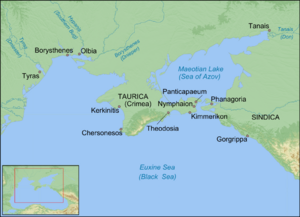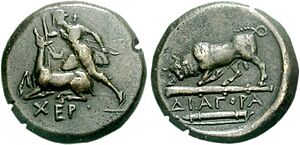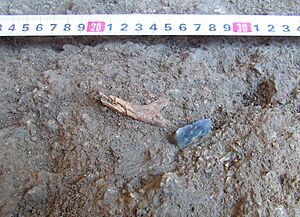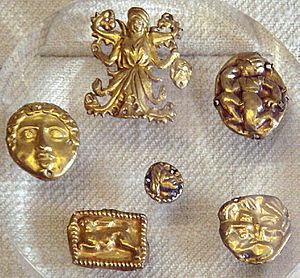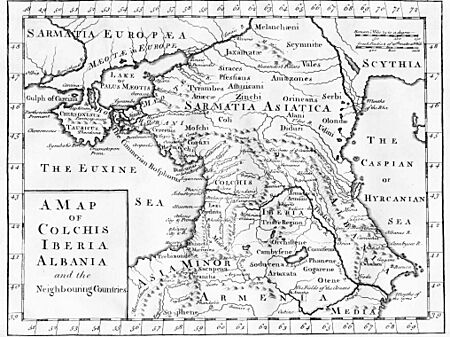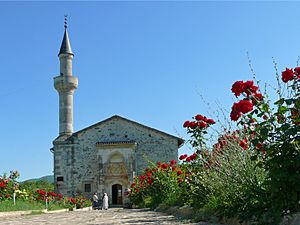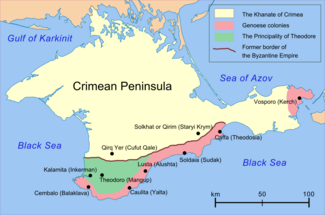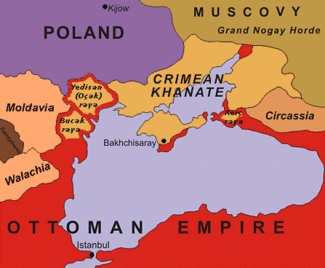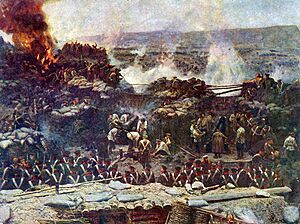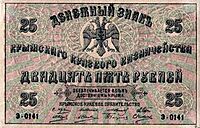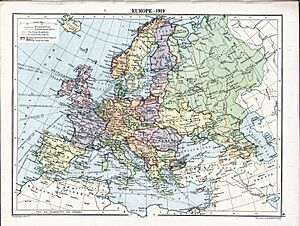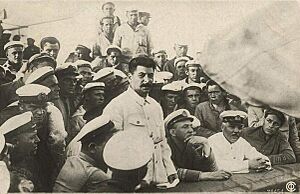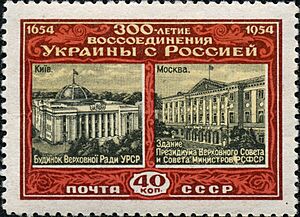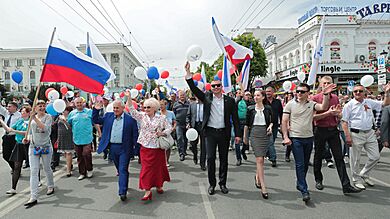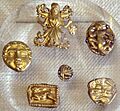History of Crimea facts for kids
The Crimean Peninsula has a long and interesting history. It was once known as Tauris or Taurica. Its story begins around 500 BCE when ancient Greek colonies were built along its coast. The most important was Chersonesos near today's Sevastopol. The Scythians and Tauri lived in the northern inland areas.
Over time, the southern coast became part of the Bosporan Kingdom. This kingdom later joined Pontus and then became a state connected to Rome (63 BC – 341 AD). Greek culture stayed strong on the south coast for nearly 2,000 years. This continued under the Byzantine Empire (341–1204), the Empire of Trebizond (1204–1461), and the independent Principality of Theodoro (ended 1475).
In the 1200s, some Crimean port cities were controlled by traders from Venice and Genoa. But the inner parts of Crimea faced many invasions and changes. In the Middle Ages, parts were conquered by Kievan Rus'. Their prince, Vladimir the Great, was baptized at Sevastopol. This event helped start Christianity in Kievan Rus'.
During the Mongol invasion of Europe, the north and center of Crimea fell to the Mongol Golden Horde. In the 1440s, the Crimean Khanate formed as the Golden Horde weakened. However, it soon came under the control of the Ottoman Empire. The Ottomans also took over coastal areas that were independent of the Khanate. A major way people made money during these times was through raids into Russia to capture people for sale.
In 1774, the Ottoman Empire was defeated by Catherine the Great of Russia. After many wars, the Russian navy had destroyed the Ottoman fleet. The Treaty of Küçük Kaynarca made the Tatars of Crimea politically independent. In 1783, Catherine the Great officially took Crimea into the Russian Empire. This made Russia much stronger in the Black Sea area. Crimea was the first Muslim land to leave the Ottoman Sultan's rule.
From 1853 to 1856, Crimea's important location for controlling the Black Sea led to the main battles of the Crimean War. Russia lost this war to an alliance led by France.
During the Russian Civil War, Crimea changed hands many times. It was the last place where General Wrangel's anti-Bolshevik White Army fought in 1920. Many people who stayed were killed as part of the Red Terror. In 1921, the Crimean ASSR was created as a self-governing republic within the Russian SFSR.
During World War II, Germany occupied Crimea until 1944. The Crimean ASSR was changed to an oblast (province) in 1945. This happened after the Crimean Tatars were forcibly removed by the Soviet government. In 1954, Crimea was given to the Ukrainian SSR. This was part of celebrations for the 300th anniversary of the Treaty of Pereyaslav.
After the dissolution of the Soviet Union, the Republic of Crimea was formed in 1992. But this republic was ended in 1995. The Autonomous Republic of Crimea was then firmly established under Ukrainian rule. Sevastopol was managed as a special city. A 1997 agreement divided the Soviet Black Sea Fleet. This allowed Russia to keep its fleet in Sevastopol, and the lease was extended in 2010.
Today, Crimea's status is debated. In 2014, there were big protests in Crimea against the removal of the Ukrainian president. Pro-Russian forces then took control of key places. The Republic of Crimea declared independence after a disputed vote. Russia then officially took Crimea. However, most countries still see Crimea as part of Ukraine.
Contents
Prehistory
Evidence shows that people lived in Crimea as far back as the Middle Paleolithic period. Neanderthal remains found in Kiyik-Koba Cave are about 80,000 years old. Later Neanderthal sites have also been found.
Archaeologists found some of the earliest remains of modern humans in Europe in the Buran-Kaya caves. These caves are in the Crimean Mountains. The fossils are about 32,000 years old. Tools found there are linked to the Gravettian culture.
During the last Ice Age, Crimea was a safe place for people. It helped re-populate north-central Europe after the Ice Age ended. Many human sites were found in Crimea from around 16,000 years ago.
Some scientists believe Crimea became a peninsula more recently. This happened when the Black Sea level rose around 6000 BC.
The Neolithic period in Crimea began with pottery making. It also saw new ways of making flint tools. Pigs were also domesticated locally. The first evidence of farmed wheat in Crimea is from the Ardych-Burun site. This dates to the middle of the 4th millennium BC.
By 3000 BC, the Yamna culture reached Crimea. This culture is thought to be an early form of Proto-Indo-European culture.
Antiquity
Tauri and Scythians
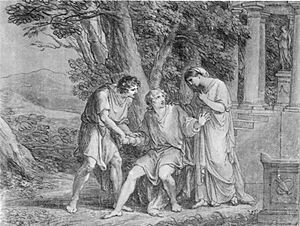
In the early Iron Age, two groups lived in Crimea. The Tauri lived in the south, separated by the Crimean Mountains. The Iranic Scythians lived in the north.
The Taurians and Scythians mixed from the late 3rd century BC. Ancient Greek writers called them "Tauroscythians" or "Scythotaurians." Strabo called the Tauri a Scythian tribe. But Herodotus said the Tauri were not Scythians, even though they lived near them. The Taurians also inspired Greek myths like the story of Iphigenia and Orestes.
The ancient Greeks saw the Tauri as a wild, warlike people. Even after centuries of Greek and Roman settlement, the Tauri were not peaceful. They continued to engage in piracy on the Black Sea. By the 2nd century BC, they became allies of the Scythian king Scilurus.
Scythian tribes lived north of the Crimean Mountains. Their main city was Scythian Neapolis, near modern Simferopol. This city ruled a small kingdom between the lower Dnieper River and northern Crimea. In the 3rd and 2nd centuries BC, Scythian Neapolis had a mix of Scythian and Greek people. It had strong walls and large public buildings. The city was destroyed by the Goths in the mid-3rd century AD.
Greek settlement
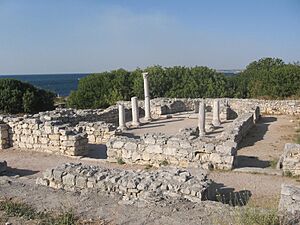
The ancient Greeks were the first to call the region Taurica after the Tauri. The Tauri only lived in the mountainous south of Crimea. So, the name Taurica first meant only that part. But later, it was used for the whole peninsula.
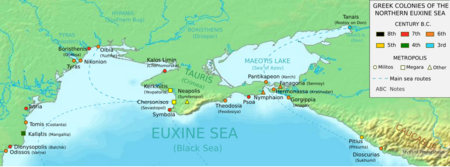
Greek city-states started building colonies along Crimea's Black Sea coast in the 7th or 6th century BC. Theodosia and Panticapaeum were founded by people from Miletus. In the 5th century BC, Dorians from Heraclea Pontica founded the port of Chersonesos (in modern Sevastopol).
The Persian Achaemenid Empire under Darius I expanded into Crimea. This was part of his campaigns against the Scythians in 513 BCE.
In 438 BC, the ruler of Panticapaeum became the King of Cimmerian Bosporus. This state had close ties with Athens, providing wheat and other goods. The last king of this line, Paerisades V, asked for help from Mithridates VI, the king of Pontus, in 114 BC. After Mithridates' death, his son, Pharnaces II, was given the Kingdom of the Cimmerian Bosporus by Pompey. This was a reward for helping the Romans in their war against his father. By 15 BC, it was given back to the king of Pontus. But from then on, it was a state that paid tribute to Rome.
Roman Empire
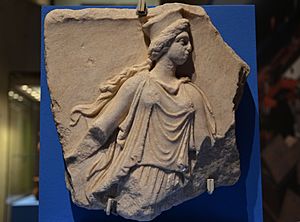
In the 2nd century BC, eastern Taurica became part of the Bosporan Kingdom. It later became a client kingdom of the Roman Empire in the 1st century BC.
During the 1st, 2nd, and 3rd centuries AD, Roman soldiers and settlers lived in Charax, Crimea. The Charax colony was built to protect Chersonesos and other trading posts from the Scythians. Roman soldiers from the Legio I Italica protected the colony. A group from the Legio XI Claudia was also there in the late 2nd century. The Romans left the camp in the mid-3rd century.
In later centuries, Crimea was invaded or occupied by different groups. These included the Goths (AD 250), the Huns (376), the Bulgars (4th–8th century), and the Khazars (8th century).
Crimean Gothic, a language related to German, was spoken by the Crimean Goths. It was used in some isolated parts of Crimea until the late 1700s.
Middle Ages
Rus' and Byzantium
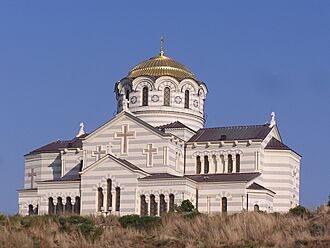
In the 800s AD, the Byzantine Empire created the Theme of Cherson. This was to defend against attacks from the Rus' Khaganate. From this time, the Crimean peninsula was fought over by Byzantium, Rus', and Khazaria. The area was a place where early medieval Slavic, Turkic, and Greek cultures met.
It became a center for slave trade. Slavic people were sold to Byzantium and other places in Anatolia and the Middle East.
In the mid-900s, Prince Sviatoslav I of Kiev conquered eastern Crimea. It became part of the Kievan Rus' principality of Tmutarakan. The Kievan Rus' took the peninsula from the Byzantines in the 900s. A major Byzantine outpost, Chersonesus, was captured in 988 CE. A year later, Grand Prince Vladimir of Kiev married Emperor Basil II's sister Anna. He was baptized by a local Byzantine priest at Chersonesus. This marked the entry of Rus' into the Christian world. Chersonesus Cathedral marks this historic spot.
After the Norman Conquest of England, many English people fled to Byzantine lands. They are said to have settled in Crimea.
As the Byzantine state weakened, some cities fell to its creditor, the Republic of Genoa. Genoa also conquered cities controlled by its rival, Venice. During this whole period, people in the cities spoke Greek and were Eastern Christian.
The Crimean steppe
Throughout ancient and medieval times, the inner and northern parts of Crimea were home to many different groups of steppe nomads. These included the Tauri, Cimmerians, Scythians, Sarmatians, Crimean Goths, Alans, Bulgars, Huns, Khazars, Kipchaks, and Mongols.
The Bosporan Kingdom controlled most of the peninsula when it was strongest. Kievan Rus' also had some control of inner Crimea after the 900s.
Mongol invasion and later medieval period
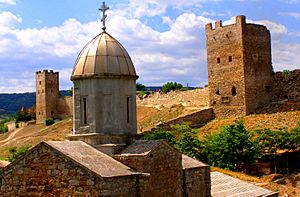
The overseas lands of Trebizond, called Perateia, were already under pressure from the Genoese and Kipchaks. This was before the Mongol invasions began in 1223.
Kiev lost its hold on inner Crimea in the early 1200s due to the Mongol invasions. In the summer of 1238, Batu Khan attacked the Crimean peninsula. He reached Kiev by 1240. The Crimean interior came under the control of the Turco-Mongol Golden Horde from 1239 to 1441. The name Crimea comes from the name of the Golden Horde's capital, the city now known as Staryi Krym.
Trebizond's Perateia soon became the Principality of Theodoro and Genoese Gazaria. They shared control of southern Crimea until the Ottoman invasion in 1475.
In the 1200s, the Republic of Genoa took over settlements built by their rivals, the Venetians. These were along the Crimean coast. Genoa established itself at Cembalo (today's Balaklava), Soldaia (Sudak), Cherco (Kerch), and Caffa (Feodosiya). Genoa controlled Crimea's economy and Black Sea trade for two centuries. Genoa and its colonies fought a series of wars with the Mongol states.
In 1346, the Golden Horde army attacked Genoese Kaffa. They used catapults to throw bodies of Mongol warriors who had died of plague over the city walls. Some historians think that Genoese refugees from this event might have brought the Black Death to Western Europe.
Crimean Khanate (1443–1783)
After Timur defeated a Mongol Golden Horde army in 1399, the Crimean Tatars formed their own Crimean Khanate. This happened under Hacı I Giray (a descendant of Genghis Khan) by 1443. Hacı I Giray and the rulers after him first lived at Qırq Yer. Then, from the early 1400s, they lived at Bakhchisaray.
The Crimean Tatars controlled the steppes from the Kuban to the Dniester River. But they could not take control of the trading towns in Crimea that belonged to Genoa. In 1462, Kaffa recognized Polish rule, though this was only in name. The Crimean Tatars asked the Ottomans for help. An Ottoman invasion of the Genoese towns, led by Gedik Ahmed Pasha in 1475, brought Kaffa and other trading towns under Ottoman control.
After capturing the Genoese towns, the Ottoman Sultan held Khan Meñli I Giray captive. He later released him. In return, the Khan accepted Ottoman rule over the Crimean Khans. This allowed them to rule as tributary princes of the Ottoman Empire. However, the Crimean Khans still had a lot of freedom from the Ottoman Empire. They followed the rules they thought were best for them.
Crimean Tatars started the practice of raids into Eastern Slavic lands. They captured people for sale. For example, from 1450 to 1586, 86 Tatar raids were recorded. From 1600 to 1647, there were 70 raids. In the 1570s, almost 20,000 people were sold each year in Kaffa.
People who were captured or freed made up about 75% of Crimea's population. In 1769, a last major Tatar raid happened during the Russo-Turkish War of 1768-1774. About 20,000 people were captured.
Tatar society
The Crimean Tatars were the main ethnic group in the Crimean Khanate from the 1400s to the 1700s. They came from a mix of Turkic peoples who settled in Crimea from the 700s. They likely also included parts of the Crimean Goths and the Genoese. The Crimean Tatar language is related to the Khazars, who invaded Crimea in the mid-700s. It is part of the Kipchak branch of Turkic languages. But it also has a lot of influence from Oghuz Turkish because of the Ottoman presence in Crimea.
A small group of Crimean Karaites formed in the 1200s. They are of Jewish descent and practice Karaism. They later adopted a Turkic language. They lived among the Muslim Crimean Tatars, mostly in the mountainous Çufut Qale area.
Cossack incursions
In 1553–1554, Cossack Hetman Dmytro Vyshnevetsky gathered groups of Cossacks. He built a fort to stop Tatar raids into Ukraine. With this, he founded the Zaporozhian Sich. From here, he launched attacks on the Crimean Peninsula and the Ottoman Turks.
Independent Khanate
In 1774, the Ottoman Empire was defeated by Catherine the Great. After two centuries of fighting, the Russian fleet had destroyed the Ottoman navy. The Russian army had also won big victories against Ottoman land forces.
The Treaty of Küçük Kaynarca, signed in June 1774, forced the Ottomans to recognize the Tatars of Crimea as politically independent. This meant the Crimean Khans came under Russian influence.
Crimea was the first Muslim territory to leave the Sultan's rule. The Ottoman Empire's borders would slowly shrink. Russia would then push its border westward to the Dniester.
The Khanate then slowly fell apart. This was especially true after a pogrom caused many Christian people to leave. These Christians were mostly city dwellers and helped create cities like Mariupol.
Russian Empire (1783–1917)
Russian annexation
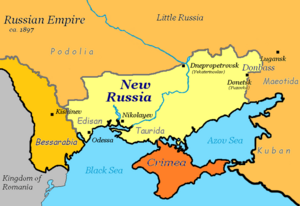
On December 28, 1783, the Ottoman Empire made a trade agreement with the Russian diplomat Yakov Bulgakov. This agreement recognized the loss of Crimea and other lands that the Khanate had held. This increased Russia's power in the Black Sea area.
Crimea went through several changes in how it was governed after Russia took control. First, it was the Taurida Oblast in 1784. But in 1796, it was divided into two counties and added to the Novorossiysk Governorate. A new Taurida Governorate was set up in 1802, with its capital at Simferopol. This governorate included Crimea and larger nearby areas on the mainland. In 1826, Adam Mickiewicz published his famous work The Crimean Sonnets after traveling along the Black Sea Coast.
Crimean War
The Crimean War (1853–1856) was a conflict between the Russian Empire and an alliance of the French Empire, the British Empire, the Ottoman Empire, the Kingdom of Sardinia, and the Duchy of Nassau. This war was part of a long struggle between major European powers. They wanted influence over the lands of the weakening Ottoman Empire. Russia and the Ottoman Empire went to war in October 1853. The reason was Russia's claim to protect Orthodox Christians. To stop Russia's gains, France and Britain joined the war in March 1854. While some fighting happened elsewhere, the main battles were in Crimea.
The immediate cause of the war involved the rights of Christian groups in Palestine. Palestine was part of the Ottoman Empire. France supported the rights of Roman Catholics, and Russia supported those of the Eastern Orthodox Church. Longer-term causes included the decline of the Ottoman Empire. Also, the Russian Empire had been expanding in earlier wars with the Ottomans. Britain and France wanted to keep the Ottoman Empire strong to maintain a balance of power in Europe. Many have noted that the reasons for the war, in one case involving an argument over a key, showed a "greater confusion of purpose." But it led to a war known for its "notoriously incompetent international butchery."
After fighting in the Danubian Principalities and the Black Sea, allied troops landed in Crimea in September 1854. They then attacked the city of Sevastopol. This city was home to the Tsar's Black Sea Fleet. It was seen as a threat of Russian expansion into the Mediterranean. After much fighting across Crimea, the city fell on September 9, 1855. The war ended with Russia's defeat in February 1856.
Late Imperial era
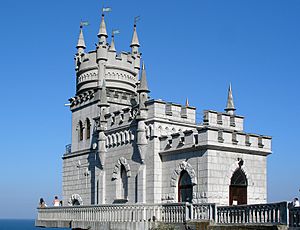
The war badly damaged Crimea's economy and society. Many Crimean Tatars had to leave their homeland. This was due to the war, unfair treatment, and land being taken. Those who survived the journey, hunger, and disease moved to Dobruja, Anatolia, and other parts of the Ottoman Empire. Eventually, the Russian government tried to stop this. Agriculture was suffering because fertile farmland was left empty. By the late 1800s, Crimean Tatars were still the largest group in Crimea's mostly rural population. They were the main group in the mountains and about half of the steppe population.
There were many Russians in the Feodosiya district. There were also Ukrainians and smaller numbers of Jews (including Krymchaks and Crimean Karaites). Other groups included Belarusians, Turks, Armenians, Greeks, and Roma. Germans and Bulgarians settled in Crimea in the early 1800s. They received large amounts of fertile land. Later, wealthy settlers began to buy land, mostly in the Perekopsky and Evpatoria areas.
Russian Civil War (1917–1922)
After the Russian Revolution of 1917, the situation in Crimea was very chaotic. This was like much of Russia. During the Russian Civil War, Crimea changed hands many times. For a while, it was a stronghold for the anti-Bolshevik White Army. It was in Crimea that the White Russians, led by General Wrangel, made their last stand against Nestor Makhno and the Red Army in 1920. When their resistance was crushed, many anti-Bolshevik fighters and civilians escaped by ship to Istanbul.
About 50,000 White prisoners of war and civilians were killed by shooting or hanging. This happened after General Wrangel's defeat at the end of 1920. This is seen as one of the largest mass killings in the Civil War.
Between 56,000 and 150,000 civilians were then killed as part of the Red Terror. This was organized by Béla Kun.
Crimea changed hands several times during the conflict. Several different governments were set up on the peninsula.
Soviet Union (1922–1991)
Between the World Wars
Crimea became part of the Russian Soviet Federative Socialist Republic on October 18, 1921. It was called the Crimean Autonomous Soviet Socialist Republic. The Russian SFSR founded the Union of Soviet Socialist Republics in 1922. The Crimean ASSR kept some self-rule and was run as a Crimean Tatar area.
However, this did not protect the Crimean Tatars from Joseph Stalin's harsh rule in the 1930s. They made up about 25% of Crimea's population. The Greeks were another group that suffered. They lost their lands during collectivization. This was when farmers were not paid wages. Schools that taught Greek were closed. Greek books were destroyed. This was because the Soviets saw Greeks as "counter-revolutionary" due to their ties to capitalist Greece.
From 1923 until 1944, there was an effort to create Jewish settlements in Crimea. There were two attempts to create Jewish autonomy in Crimea, but both failed.
Crimea faced two severe famines in the 1900s. These were the Famine of 1921–1922 and the Holodomor of 1932–1933. Many Slavic people (mostly Russians and Ukrainians) moved to Crimea in the 1930s. This was due to the Soviet policy of developing regions. These changes permanently altered the mix of ethnic groups in the area.
World War II
During World War II, Crimea saw some of the bloodiest battles. The leaders of Nazi Germany wanted to conquer and settle the fertile peninsula. This was part of their plan to move Germans into Eastern Europe. In the Crimean campaign, German and Romanian troops suffered many losses in the summer of 1941. They tried to advance through the narrow Isthmus of Perekop that connects Crimea to the Soviet mainland. Once the German army broke through, they occupied most of Crimea. The city of Sevastopol was an exception. It was attacked and later given the title of Hero City. The Red Army lost over 170,000 soldiers killed or captured.
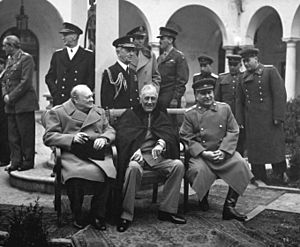
Sevastopol held out from October 1941 until July 4, 1942. That's when the Germans finally captured the city. From September 1, 1942, the peninsula was managed by the Nazi Generalkommissar Alfred Eduard Frauenfeld. This was under the authority of the three Reichskommissare for all of Ukraine. Despite harsh tactics by the Nazis and help from Romanian and Italian troops, the Crimean mountains remained a stronghold for local resistance fighters. This lasted until the peninsula was freed from occupation.
The Crimean Jews were targeted for killing during the Nazi occupation. According to Yitzhak Arad, a company of Tatar volunteers was formed in Simferopol in January 1942. This group helped in hunting down and killing Jews in rural areas. Around 40,000 Crimean Jews were killed.
The successful Crimean offensive meant that in 1944, Sevastopol came under Soviet control. The city, once known for its beautiful buildings, was completely destroyed. It had to be rebuilt stone by stone. Because of its huge historical and symbolic meaning for Russians, Stalin and the Soviet government made it a priority to restore it quickly.
The Crimean port of Yalta hosted the Yalta Conference. Here, Roosevelt, Stalin, and Churchill met. This meeting was later seen as dividing Europe between Communist and democratic areas.
Deportation of the Crimean Tatars
On May 18, 1944, the entire population of the Crimean Tatars was forcibly moved in the "Sürgün" (Crimean Tatar for exile). They were sent to Central Asia by Joseph Stalin's Soviet government. This was a form of collective punishment. The reason given was that they had supposedly worked with the Nazi forces and formed pro-German groups. On June 26 of the same year, Armenian, Bulgarian, and Greek people were also moved to Central Asia. Some went to Ufa and its surroundings in the Ural mountains.
More than 230,000 people in total were moved. This was about a fifth of Crimea's population at that time. They were mainly sent to Uzbekistan. About 14,300 Greeks, 12,075 Bulgarians, and 10,000 Armenians were also expelled. By the end of summer 1944, the ethnic cleansing of Crimea was complete. In 1967, the Crimean Tatars were officially cleared of wrongdoing. But they were not allowed to legally return to their homeland until the last days of the Soviet Union. The forced movement was officially recognized as a genocide by Ukraine and three other countries between 2015 and 2019.
The peninsula was then settled by other people, mostly Russians and Ukrainians. Experts today say the deportation was part of a Soviet plan. This plan was to gain access to the Dardanelles and take land in Turkey. The Tatars had Turkic relatives there. Or it was to remove minority groups from the Soviet Union's border regions.
Nearly 8,000 Crimean Tatars died during the forced move. Tens of thousands more died later due to the harsh conditions of exile. The Crimean Tatar deportation led to 80,000 homes and 360,000 acres of land being left empty.
Post-World War II
The self-governing republic, now without its main ethnic group, was changed to an oblast (province) within the Russian SFSR. This happened on June 30, 1945. A process of de-Tatarization of Crimea began. This was to remove the memory of the Tatars. It included changing most place names to Slavic and communist names. Only a few places, like Bakhchysarai, Dzhankoy, İşün, Alushta, Alupka, and Saky, got their original names back after the Soviet Union fell.
1954 transfer to Ukraine SSR
On February 19, 1954, the oblast was transferred from the Russian SFSR to the Ukrainian SSR. This was because of "the economy being connected, the close location, and the strong economic and cultural ties" between Crimea and the Ukrainian SSR. It also marked the 300th anniversary of Ukraine's union with Russia.
Sevastopol was a closed city because it was an important port for the Soviet Black Sea Fleet. It was only added to the Crimean Oblast in 1978.
The building of the North Crimean Canal started in 1957. This canal was for watering farms in southern Ukraine and Crimea. The main work happened between 1961 and 1971. Young volunteers from the Komsomol youth organization helped build it. About 10,000 "volunteer" workers were involved.
In the years after the war, Crimea became a popular tourist destination. New attractions and health resorts were built. Tourists came from all over the Soviet Union and its allied countries, especially from East Germany. Over time, Crimea also became a major tourist spot for cruises from Greece and Turkey. Crimea's roads and factories also grew. This was especially true around the seaports at Kerch and Sevastopol and in the capital, Simferopol. The populations of both Ukrainians and Russians doubled. This was due to policies that encouraged people to mix. By 1989, more than 1.6 million Russians and 626,000 Ukrainians lived on the peninsula.
Post-Soviet Union
Ukraine (1991–2014)
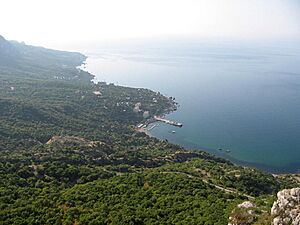
When the dissolution of the Soviet Union happened and Ukraine became independent, the ethnic Russian Crimean peninsula was reorganized. It became the Republic of Crimea. This followed a 1991 vote. Crimean authorities wanted more independence from Ukraine and closer ties with Russia. In 1995, Ukraine officially ended the Republic. The Autonomous Republic of Crimea was then firmly established under Ukrainian authority. There were also ongoing tensions with Russia over the Soviet Fleet. However, a 1997 agreement divided the Soviet Black Sea Fleet. This allowed Russia to keep its fleet in Sevastopol, and the lease was extended in 2010. As a result of the overthrow of the relatively pro-Russian president Viktor Yanukovych, Russia took Crimea in 2014.
Russian annexation
The events in Kyiv that removed Ukrainian president Viktor Yanukovych led to protests against the new Ukrainian government in Crimea. At the same time, Russian president Vladimir Putin discussed Ukrainian events with security chiefs. He said, "we must start working on returning Crimea to Russia." On February 27, Russian troops took control of important sites across Crimea. This led to the pro-Russian Aksyonov government being put in place in Crimea. Then came the Crimean status referendum and the declaration of Crimea's independence on March 16, 2014. Russia first said its military was not involved. But it later admitted they were. Russia officially took Crimea on March 18, 2014. After this, Russia increased its military presence on the peninsula. It also made nuclear threats to make its new control clear.
Ukraine and many other countries said the annexation was wrong. They see it as a violation of international law and Russia's agreements to protect Ukraine's borders. The annexation led to other members of the then-G8 suspending Russia from the group. They also put sanctions on Russia. The United Nations General Assembly also rejected the vote and annexation. It passed a resolution saying Ukraine's borders should be respected.
A survey by Pew Research Center in 2014 found that most Crimean residents believed the referendum was fair (91%). They also thought the government in Kyiv should accept the results (88%).
The Russian government does not like the term "annexation." Putin said the referendum followed the idea of self-determination for people.
Aftermath
Days after the agreement was signed, Crimea began to join the Russian federation. The Russian ruble became official money. Later, it was the only legal currency. Clocks were also changed to Moscow time. A new version of the Russian Constitution was released. It added the Republic of Crimea and the city of Sevastopol to the federal subjects of the Russian Federation. The Russian Prime Minister Dmitry Medvedev said Crimea was fully part of Russia. Since the annexation, Russia has supported many people moving into Crimea.
Once Ukraine lost control of the area in 2014, it cut off the water supply from the North Crimean Canal. This canal provides 85% of Crimea's fresh water from the Dnieper river. It was very hard to find new water sources to replace the Ukrainian ones. In 2022, Russia conquered parts of Kherson Oblast. This allowed it to unblock the North Crimean canal by force. Water supply to Crimea then started again.
Russian invasion of Ukraine
Starting in July 2022, there were many explosions and fires on the Russian-occupied Crimean Peninsula. The Russian Army had launched its attack on Southern Ukraine from Crimea during the full-scale invasion of Ukraine. Occupied Crimea was a base for the later Russian occupation of Kherson Oblast and Russian occupation of Zaporizhzhia Oblast. The Ukrainian government has not said it was responsible for all of the attacks.
Images for kids
-
Orestes, a curly-haired young man in a Greek robe, is seated before a small group of trees, clasping the right hand of another Greek man, who is standing with his left hand on the seated man's arm. Standing to their left but in the right of the painting is a tall, robed woman of elegant bearing. Behind her are two columns of a classic Greek temple. Low mountains are in the far background.
See also
 In Spanish: Historia de Crimea para niños
In Spanish: Historia de Crimea para niños
- Kizil-Koba culture
- Cimmerians
- Tauri
- Scythian Neapolis
- Greeks in pre-Roman Crimea
- Chersonesus
- Bosporan Kingdom
- Kingdom of Pontus
- Crimea in the Roman era
- Akatziri
- Crimean Goths
- Crimean Tatars
- Crimean Khanate
- Khazars
- Crimean Karaites
- Annexation of Crimea by the Russian Empire
- Taurida Oblast
- Novorossiya Governorate
- Taurida Governorate
- Crimean War
- Crimean People's Republic
- Taurida Soviet Socialist Republic
- Crimean Regional Government
- Crimean Socialist Soviet Republic
- South Russian Government
- Government of South Russia
- Crimea in the Soviet Union
- Crimean Oblast
- Crimean ASSR (1991–1992)
- Republic of Crimea (1992–1995)
- Autonomous Republic of Crimea


